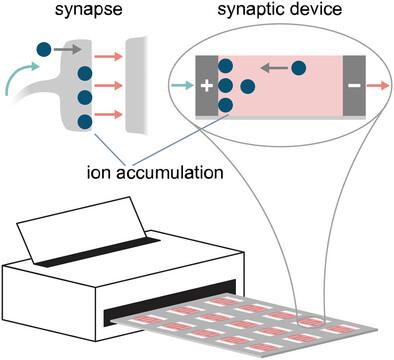当前位置:
X-MOL 学术
›
Adv. Electron. Mater.
›
论文详情
Our official English website, www.x-mol.net, welcomes your
feedback! (Note: you will need to create a separate account there.)
Scalable Fabrication of Neuromorphic Devices Using Inkjet Printing for the Deposition of Organic Mixed Ionic‐Electronic Conductor
Advanced Electronic Materials ( IF 5.3 ) Pub Date : 2024-11-04 , DOI: 10.1002/aelm.202400479 Fabian Gärisch, Vincent Schröder, Emil J. W. List‐Kratochvil, Giovanni Ligorio
Advanced Electronic Materials ( IF 5.3 ) Pub Date : 2024-11-04 , DOI: 10.1002/aelm.202400479 Fabian Gärisch, Vincent Schröder, Emil J. W. List‐Kratochvil, Giovanni Ligorio

|
Recent advancements in artificial intelligence (AI) have highlighted the critical need for energy‐efficient hardware solutions, especially in edge‐computing applications. However, traditional AI approaches are plagued by significant power consumption. In response, researchers have turned to biomimetic strategies, drawing inspiration from the ion‐mediated operating principle of biological synapses, to develop organic neuromorphic devices as promising alternatives. Organic mixed ionic‐electronic conductor (OMIEC) materials have emerged as particularly noteworthy in this field, due to their potential for enhancing neuromorphic computing capabilities. Together with device performance, it is crucial to select devices that allow fabrication via scalable techniques. This study investigates the fabrication of OMIEC‐based neuromorphic devices using inkjet printing, providing a scalable and material‐efficient approach. Employing a commercially available polymer mixed ionic‐electronic conductor (BTEM‐PPV) and a lithium salt, inkjet‐printed devices exhibit performance comparable to those fabricated via traditional spin‐coating methods. These two‐terminal neuromorphic devices demonstrate functionality analogous to literature‐known devices and demonstrate promising frequency‐dependent short‐term plasticity. Furthermore, comparative studies with previous light‐emitting electrochemical cells (LECs) and neuromorphic OMIEC devices validate the efficacy of inkjet printing as a potential fabrication technique. The findings suggest that inkjet printing is suitable for large‐scale production, offering reproducible and stable fabrication processes. By adopting the OMIEC material system, inkjet printing holds the potential for further enhancing device performance and functionality. Overall, this study underscores the viability of inkjet printing as a scalable fabrication method for OMIEC‐based neuromorphic devices, paving the way for advancements in AI hardware.
中文翻译:

使用喷墨打印制备神经形态器件的可扩展制造,用于有机混合离子-电子导体的沉积
人工智能 (AI) 的最新进展凸显了对高能效硬件解决方案的迫切需求,尤其是在边缘计算应用中。然而,传统的 AI 方法受到大量功耗的困扰。作为回应,研究人员转向仿生策略,从生物突触的离子介导工作原理中汲取灵感,开发有机神经形态器件作为有前途的替代品。有机混合离子电子导体 (OMIEC) 材料在这一领域尤其值得注意,因为它们具有增强神经形态计算能力的潜力。除了器件性能外,选择允许通过可扩展技术制造的器件也至关重要。本研究调查了使用喷墨打印制造基于 OMIEC 的神经形态器件,提供了一种可扩展且材料高效的方法。喷墨打印器件采用市售的聚合物混合离子电子导体 (BTEM-PPV) 和锂盐,其性能可与通过传统旋涂方法制造的器件相媲美。这些双末端神经形态装置表现出类似于文献中已知的装置的功能,并显示出有希望的频率依赖性短期可塑性。此外,与以前的发光电化学电池 (LEC) 和神经形态 OMIEC 设备的比较研究验证了喷墨打印作为一种潜在制造技术的有效性。研究结果表明,喷墨打印适用于大规模生产,提供可重复和稳定的制造工艺。通过采用 OMIEC 材料系统,喷墨打印具有进一步增强设备性能和功能的潜力。 总体而言,这项研究强调了喷墨打印作为基于 OMIEC 的神经形态设备的可扩展制造方法的可行性,为 AI 硬件的进步铺平了道路。
更新日期:2024-11-04
中文翻译:

使用喷墨打印制备神经形态器件的可扩展制造,用于有机混合离子-电子导体的沉积
人工智能 (AI) 的最新进展凸显了对高能效硬件解决方案的迫切需求,尤其是在边缘计算应用中。然而,传统的 AI 方法受到大量功耗的困扰。作为回应,研究人员转向仿生策略,从生物突触的离子介导工作原理中汲取灵感,开发有机神经形态器件作为有前途的替代品。有机混合离子电子导体 (OMIEC) 材料在这一领域尤其值得注意,因为它们具有增强神经形态计算能力的潜力。除了器件性能外,选择允许通过可扩展技术制造的器件也至关重要。本研究调查了使用喷墨打印制造基于 OMIEC 的神经形态器件,提供了一种可扩展且材料高效的方法。喷墨打印器件采用市售的聚合物混合离子电子导体 (BTEM-PPV) 和锂盐,其性能可与通过传统旋涂方法制造的器件相媲美。这些双末端神经形态装置表现出类似于文献中已知的装置的功能,并显示出有希望的频率依赖性短期可塑性。此外,与以前的发光电化学电池 (LEC) 和神经形态 OMIEC 设备的比较研究验证了喷墨打印作为一种潜在制造技术的有效性。研究结果表明,喷墨打印适用于大规模生产,提供可重复和稳定的制造工艺。通过采用 OMIEC 材料系统,喷墨打印具有进一步增强设备性能和功能的潜力。 总体而言,这项研究强调了喷墨打印作为基于 OMIEC 的神经形态设备的可扩展制造方法的可行性,为 AI 硬件的进步铺平了道路。


















































 京公网安备 11010802027423号
京公网安备 11010802027423号